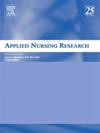Sleep quality and predicting factors among patients undergoing hemodialysis: A descriptive cross sectional study
IF 2.2
4区 医学
Q1 NURSING
引用次数: 0
Abstract
Background
Many patients with end-stage renal disease (ESRD) undergoing hemodialysis encounter sleep disturbances. This study aimed to assess the quality of sleep and identify the factors predicting it among patients undergoing hemodialysis.
Methods
A descriptive, cross-sectional design was used. The study was carried out in the hemodialysis unit at Zagazig University Hospitals. A convenient sample of 81 patients who were receiving hemodialysis was selected. Data collected by using Patient Interview Questionnaire, Factors Affecting Sleep Pattern Questionnaire, and Pittsburgh Sleep Quality Index (PSQI). ANOVA test was utilized for data analysis.
Results
93.8 % of patients exhibited poor sleep quality (PSQI >5). The mostly reported factors that could affect patients' sleep pattern were daytime napping (67.9 %), sharing a room with others (79 %), pruritus (79 %), muscle cramps (79 %), chronic pain (79 %), and feel of weakness (86.4 %). There was a statistical significant relation between sleep quality and comorbidity (P = 0.004), skin problems (P = 0.001). A strong positive statistical significant correlation was found between sleep quality and age, dialysis duration, schedule/week, session/h, health problems, and factors affecting sleep pattern with (P = 0.001). Health problems, education, age, and occupation were statistically significant predictors affecting sleep quality detected by the step wise multiple linear regression.
Conclusion
Sleep quality is poor among the majority of patients. The reported factors that may affect their sleep pattern were daytime napping, sharing a room with others, skin itching, muscle cramps, persistent pain, and feel of weakness. The predicting factors affecting sleep quality were health problems, education, age, and occupation.
血液透析患者的睡眠质量及其预测因素:一项描述性横断面研究
背景:许多接受血液透析的终末期肾病(ESRD)患者会遇到睡眠障碍。本研究旨在评估血液透析患者的睡眠质量,并确定预测睡眠质量的因素。方法采用描述性、横断面设计。这项研究是在扎加齐格大学医院的血液透析部门进行的。选择了81名接受血液透析的患者作为方便的样本。采用患者访谈问卷、睡眠模式影响因素问卷和匹兹堡睡眠质量指数(PSQI)收集数据。结果93.8%的患者表现为睡眠质量差(PSQI >5)。据报道,影响患者睡眠模式的主要因素是白天午睡(67.9%)、与他人合住(79%)、瘙痒(79%)、肌肉痉挛(79%)、慢性疼痛(79%)和无力感(86.4%)。睡眠质量与合并症(P = 0.004)、皮肤问题(P = 0.001)有统计学意义相关。睡眠质量与年龄、透析持续时间、透析时间/周、透析时间/小时、健康问题和影响睡眠模式的因素有显著正相关(P = 0.001)。健康问题、教育程度、年龄和职业是影响睡眠质量的统计学显著预测因素。结论多数患者睡眠质量较差。据报道,可能影响他们睡眠模式的因素包括白天打盹、与他人合住一个房间、皮肤瘙痒、肌肉痉挛、持续疼痛和感觉虚弱。影响睡眠质量的预测因素有健康问题、教育程度、年龄和职业。
本文章由计算机程序翻译,如有差异,请以英文原文为准。
求助全文
约1分钟内获得全文
求助全文
来源期刊

Applied Nursing Research
医学-护理
CiteScore
4.50
自引率
0.00%
发文量
65
审稿时长
70 days
期刊介绍:
Applied Nursing Research presents original, peer-reviewed research findings clearly and directly for clinical applications in all nursing specialties. Regular features include "Ask the Experts," research briefs, clinical methods, book reviews, news and announcements, and an editorial section. Applied Nursing Research covers such areas as pain management, patient education, discharge planning, nursing diagnosis, job stress in nursing, nursing influence on length of hospital stay, and nurse/physician collaboration.
 求助内容:
求助内容: 应助结果提醒方式:
应助结果提醒方式:


